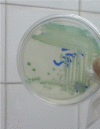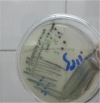Candiduria in Hospitalized Patients and Identification of Isolated Candida Species by Morphological and Molecular Methods in Ilam, Iran
- PMID: 30847324
- PMCID: PMC6401579
Candiduria in Hospitalized Patients and Identification of Isolated Candida Species by Morphological and Molecular Methods in Ilam, Iran
Abstract
Background: Candiduria in hospitalized patients may represent contamination, colonization, or urinary tract infections. On the other hand, candidemia and upper urinary tract infection could be the complications of candiduria. The aim of this study was to determine candiduria in hospitalized patients and identify isolated Candida species by conventional and molecular methods.
Methods: This cross-sectional study was conducted on hospitalized patients in Imam Khomeini and Mostafa Khomeini hospitals in Ilam, western Iran from Jan to Dec 2016. Urine samples of hospitalized patients were collected during a period of 4 months for diagnosis of candiduria. Primary identification was done by conventional methods. PCR profile was carried out using phenol-chloroform method and confirmed using restriction fragment length polymorphism (PCR-RFLP) technique by MspI restriction enzyme.
Results: Candiduria was diagnosed in 18 (9.2%) cases from a total of 195 patients. Isolated yeasts were identified as C. albicans (n: 13), C. glabrata (n: 5), and C. parapsilosis (n: 1) in the one case both C. albicans and C. glabrata were isolated from a urine sample.
Conclusion: Candida urinary tract infection is becoming increasingly common in hospitalized patients but, differentiation fungal colonization from infection and identification of etiologic agents for optimal treatment is necessary.
Keywords: Candida albicans; Candida spp.; Candiduria; Hospitalized patients; Yeast.
Conflict of interest statement
Conflict of interest The authors declare that there is no conflict of interests.
Figures






Similar articles
-
High prevalence of asymptomatic nosocomial candiduria due to Candida glabrata among hospitalized patients with heart failure: a matter of some concern?Curr Med Mycol. 2020 Dec;6(4):1-8. doi: 10.18502/cmm.6.4.5327. Curr Med Mycol. 2020. PMID: 34195453 Free PMC article.
-
Candiduria in hospitalized patients in teaching hospitals of Ahvaz.Iran J Microbiol. 2012 Dec;4(4):198-203. Iran J Microbiol. 2012. PMID: 23205252 Free PMC article.
-
Molecular identification of Candida species isolated from candiduria and its risk factors in neonates and children.Curr Med Mycol. 2021 Sep;7(3):9-12. doi: 10.18502/cmm.7.3.7799. Curr Med Mycol. 2021. PMID: 35528621 Free PMC article.
-
Candiduria; a review article with specific data from Iran.Turk J Urol. 2018 Nov;44(6):445-452. doi: 10.5152/tud.2018.54069. Turk J Urol. 2018. PMID: 31587699 Free PMC article. Review.
-
[Fungal infections and ureteral material: How to manage?].Prog Urol. 2015 May;25(6):306-11. doi: 10.1016/j.purol.2015.01.015. Epub 2015 Feb 25. Prog Urol. 2015. PMID: 25724861 Review. French.
Cited by
-
Identification of Candida Species from Clinical Samples in a Honduran Tertiary Hospital.Pathogens. 2019 Nov 15;8(4):237. doi: 10.3390/pathogens8040237. Pathogens. 2019. PMID: 31731617 Free PMC article.
-
Candida Species Isolation from Hospitalized Patients with COVID-19-A Retrospective Study.Diagnostics (Basel). 2022 Dec 6;12(12):3065. doi: 10.3390/diagnostics12123065. Diagnostics (Basel). 2022. PMID: 36553072 Free PMC article.
-
High prevalence of asymptomatic nosocomial candiduria due to Candida glabrata among hospitalized patients with heart failure: a matter of some concern?Curr Med Mycol. 2020 Dec;6(4):1-8. doi: 10.18502/cmm.6.4.5327. Curr Med Mycol. 2020. PMID: 34195453 Free PMC article.
-
Hospitalized COVID-19 Patients with Urinary Tract Infection in Iran: Candida Species Distribution and Antifungal Susceptibility Patterns.Antibiotics (Basel). 2024 Jul 8;13(7):633. doi: 10.3390/antibiotics13070633. Antibiotics (Basel). 2024. PMID: 39061315 Free PMC article.
-
Characterization of Candida species isolated from vulvovaginal candidiasis by MALDI-TOF with in vitro antifungal susceptibility profiles.Curr Med Mycol. 2021 Dec;7(4):6-11. doi: 10.18502/cmm.7.4.8405. Curr Med Mycol. 2021. PMID: 35747735 Free PMC article.
References
LinkOut - more resources
Full Text Sources
Research Materials
Miscellaneous
